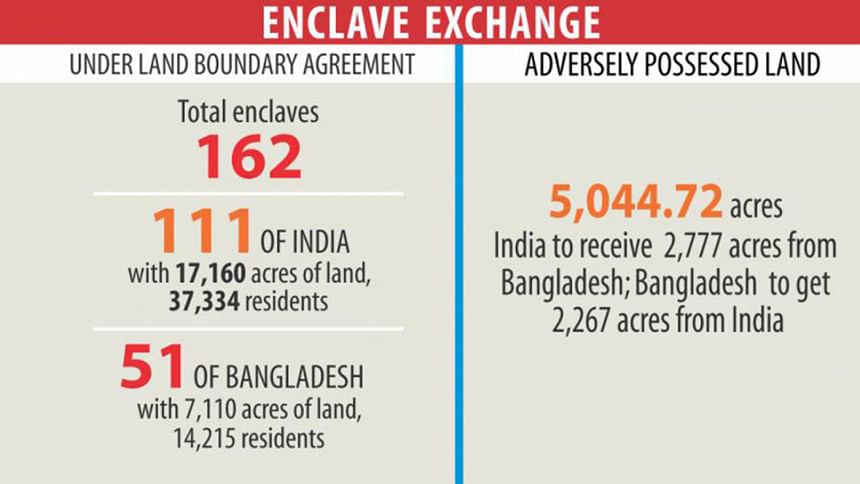Land pact rollout in next 11 months

Bangladesh and India will implement the Land Boundary Agreement (LBA) of 1974 and Protocol of 2011, in a phased manner over the next 11 months, reports The Hindu.
Between July 31, 2015 and June 30, 2016, the entire process, including physical exchange of enclaves and land parcels in adverse possession along with boundary demarcation, will be completed, according to the letters exchanged between the two Foreign Secretaries during the Prime Minister’s visit in Dhaka last week.
Perhaps the most significant date is July 31, 2015 — the “Appointed Day.” The enclaves on both sides of the border “shall stand transferred to the other” by the midnight of the day. The countries will exchange strip maps showing the narrow stretch of territory, completing the transfer of territorial jurisdiction, while the ground demarcation of the boundary will be completed by the respective Survey Departments by June 30, 2016.
Meanwhile, “India and Bangladesh will print, sign at plenipotentiary level and exchange” the strip maps of the un-demarcated sectors “by the Appointed Day.”
Both governments will facilitate “orderly, safe and secure passage” to the enclave dwellers along with their “personal belongings and moveable property” to Bangladesh or India through proper “travel documents.” The passage “will be arranged by the respective governments…[and] take place by November 30, 2015.”
“Entry/exit points will be Haldibari [on Indian side] Burimari and Banglabandha” on the international border, the exchanged letters said.
The two countries have also outlined the modalities of an immensely complex process of settlement of immovable property. The dwellers, who are hoping to move from an enclave to another country as proper citizens for the first time since Independence, will have to provide “details of the records and specifications of immovable property” to the local district administration. The details will be posted in the public domain by the administrations and the governments will “facilitate remittance of sales proceeds” of the property.
The Bangladesh-India Joint Boundary working group will address any dispute that “may arise after the transfer for the next five years till June 2020.”
However, according to some members of Bangladesh’s civil society, many key questions are yet to be addressed. “Finding out the valuation of the land that an enclave dweller has and how much land would the same person get if he or she chooses his or her original nationality and what would be its value is one of the many such questions,” said an observer in Dhaka.
Both sides have agreed “to conduct a joint visit to the enclaves” to address the complex and controversial issues.
Joint team will have to tackle nationality, population issues
With India and Bangladesh planning to complete, between July 31, 2015 and June 30, 2016, the entire process of the Land Boundary Agreement and the 2011 Protocol, one of the terms of the joint team of representatives visiting the enclaves would be to identify the “residents who wish to continue to retain the nationality they hold prior to the actual transfer of territory.”
To determine the size of the population in the 162 enclaves is one of the many issues. “We have to make sure that no one fakes identity to receive government grants,” said key activist Diptiman Sengupta, prior to Prime Minister Narendra Modi’s visit, on the Indian side of the border. The letters of the Foreign Secretaries have addressed these issues.
The right to “retain the nationality” will only be available to those “who are included in the joint headcount of the population of the enclave,” the letters said. The headcount was finalised by the governments in the joint survey of July 2011.
Besides informing the dwellers about “nationality and citizenship” the team will collect data, including photographs to issue travel documents, if the person concerned chooses to “retain his original nationality.”
“The entry, stay and secure functioning of the representatives in the joint visit and setting up of camps shall be facilitated by both governments,” the letters said.

 For all latest news, follow The Daily Star's Google News channel.
For all latest news, follow The Daily Star's Google News channel. 



Comments